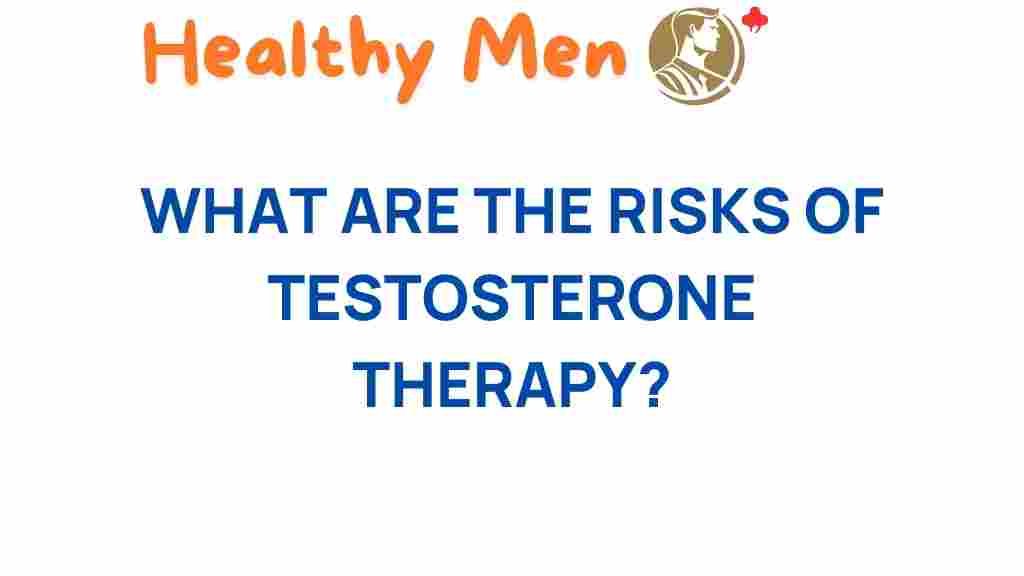Unveiling the Risks of Testosterone Therapy
Testosterone therapy has gained significant attention in recent years, particularly among men seeking to improve their vitality, energy levels, and overall health. While the allure of hormone treatment is strong, it is essential to understand the potential health risks associated with this therapy. In this article, we will explore the various aspects of testosterone therapy, including its side effects, effects on men’s health, and the importance of adhering to medical guidelines. We will also discuss the role of testosterone levels in the endocrine system and the need for patient awareness.
Understanding Testosterone Therapy
Testosterone therapy involves the administration of testosterone to individuals with low testosterone levels, also known as hypogonadism. It can be delivered through various methods, including injections, patches, gels, and pellets. The objective is to restore testosterone levels to a normal range, enhancing various aspects of health and well-being.
Why Consider Testosterone Therapy?
Men may consider testosterone therapy for several reasons, including:
- Low energy levels
- Decreased libido
- Loss of muscle mass
- Depression or mood changes
- Difficulty concentrating
While these symptoms can often be attributed to aging, stress, or lifestyle factors, low testosterone levels can play a significant role. Before starting therapy, it is crucial to undergo testing and consult with a healthcare provider.
Health Risks of Testosterone Therapy
Despite its potential benefits, testosterone therapy is not without risks. Understanding these health risks is vital for anyone considering this treatment.
Cardiovascular Risks
One of the most concerning health risks associated with testosterone therapy is its potential impact on cardiovascular health. Some studies suggest that testosterone therapy may increase the risk of:
- Heart attacks
- Strokes
- Blood clots
Men with pre-existing heart conditions or those at risk for cardiovascular disease should approach testosterone therapy with caution and consult their healthcare provider about the potential risks.
Prostate Health
Testosterone therapy may also influence prostate health. Elevated testosterone levels can stimulate the growth of prostate tissue, which may lead to:
- Benign prostatic hyperplasia (BPH)
- Increased risk of prostate cancer
Men should discuss their prostate health with their doctor before starting therapy, especially if they have a family history of prostate issues.
Endocrine System Impact
The endocrine system regulates hormones in the body, and testosterone therapy can disrupt this balance. Potential consequences include:
- Gynecomastia (breast tissue development in men)
- Infertility due to reduced sperm production
- Testicular shrinkage
It’s essential to monitor hormone levels regularly and adjust therapy as needed to minimize these risks.
Side Effects of Testosterone Therapy
In addition to the health risks mentioned above, testosterone therapy may lead to several side effects that patients should be aware of:
- Acne and oily skin
- Sleep apnea
- Fluid retention
- Increased red blood cell count (polycythemia)
- Mood swings and irritability
Patients experiencing any adverse effects should communicate with their healthcare provider to assess the need for therapy adjustments or discontinuation.
Medical Guidelines for Testosterone Therapy
To ensure safe and effective treatment, several medical guidelines are in place regarding testosterone therapy:
- Testing: Only treat men with confirmed low testosterone levels through blood tests.
- Monitoring: Regular follow-ups to monitor testosterone levels, prostate health, and any side effects.
- Personalization: Tailoring therapy based on individual health status and preferences.
Following these guidelines can help mitigate risks and ensure that testosterone therapy is appropriate for each patient.
Improving Patient Awareness
Patient awareness is crucial when it comes to testosterone therapy. Men considering this treatment should:
- Educate themselves about the potential risks and benefits.
- Discuss their medical history and any concerns with their healthcare provider.
- Understand the importance of regular monitoring and follow-up appointments.
Being proactive and informed can significantly impact the success and safety of testosterone therapy.
Step-by-Step Process for Starting Testosterone Therapy
If you and your healthcare provider decide that testosterone therapy is appropriate for you, follow this step-by-step process:
- Consultation: Schedule an appointment with your healthcare provider to discuss symptoms and concerns.
- Testing: Undergo blood tests to measure testosterone levels and assess overall health.
- Review Results: Discuss the results with your provider to determine if therapy is necessary.
- Select Treatment Method: Choose the method of testosterone administration that works best for you.
- Start Therapy: Begin the treatment as prescribed, ensuring to follow dosage instructions.
- Regular Check-ups: Attend follow-up appointments to monitor testosterone levels and health.
- Adjust as Needed: Work with your provider to make any necessary adjustments to your therapy.
Troubleshooting Common Issues
While on testosterone therapy, some patients may encounter common issues. Here are troubleshooting tips:
1. Managing Side Effects
If you experience side effects like mood swings or skin issues, contact your provider. They may adjust your dosage or suggest alternative treatments.
2. Monitoring Hormone Levels
Regular blood tests are essential to ensure testosterone levels remain within the desired range. Don’t skip these appointments.
3. Staying Informed
Keep yourself informed about the latest research and recommendations regarding testosterone therapy. Reliable sources can be found through organizations like the Endocrine Society.
Conclusion
Testosterone therapy can offer significant benefits for men suffering from low testosterone levels, but it is not without its risks. Understanding the health risks, side effects, and the importance of adhering to medical guidelines is crucial for anyone considering this treatment. By improving patient awareness and following a structured approach to therapy, men can make informed decisions about their health. Always consult with a healthcare provider to ensure that testosterone therapy is the right choice for you, and remember that knowledge is key in navigating the complexities of hormone treatment.
For more information on testosterone therapy and its implications, consider visiting resources provided by the Mayo Clinic.
This article is in the category Conditions and created by healthymen Team
